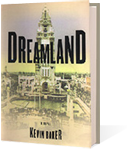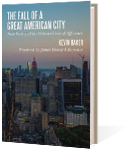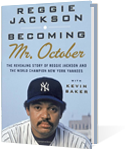Dave & Busters, anyone?
By Kevin Baker
Peer under the tent flap of our splendid new civic order, and you’re guaranteed to see a disturbing sight: all the same failed policies of the past, lovingly preserved in formaldehyde.
That’s what I got from Amy Nicholson’s thoroughly enjoyable, thoroughly enraging new documentary, Zipper: Coney Island’s Last Wild Ride, which won a special jury prize last week at DOC NYC, New York’s Documentary Film Festival and is currently making the festival rounds. Ms. Nicholson was generous enough to open her film with a quote from me about the destruction of the old Coney, though I have no other association with the production.
What she and I do share is a deep resentment over what has been done to this iconic New York neighborhood under the guise of “improving” it. Ms. Nicholson’s movie centers around the travails of Eddie Miranda, operator of a single Coney ride, the “Zipper,” a carnival perennial that was one of some 42 profitable small businesses shuttered recently by the city’s developer partners after 38 years of operation. Much of Zipper involves the very human story of Mr. Miranda, his workers, and other small-time carnies as they face the end of an era, but the larger forces at play kept dragging Ms. Nicholson—a self-described political naïf—into the looking-glass world of New York development.
Just what will happen now to Coney is anybody’s guess, following its submersion in the storm surge caused by Hurricane Sandy. But the plan for the area that the city aided and abetted is a depressingly familiar “razzle,” as the local parlance goes. Much of the area was bought up by a developer with the Dickensian moniker Joe Sitt, an impish character who specializes in acquiring properties, clearing them of tenants, then holding them in limbo until the authorities change the zoning of his parcels, greatly enhancing their value.
The razzle here is that, almost from the start, the city was playing along. Mr. Sitt was paid off at $14 million an acre, more than 10 times what his lots were originally worth—a price that approached that of top Manhattan street frontage. The city let itself be “forced” into reducing the designated amusement zone on Coney from 60 acres to just over nine, and into provisions that will likely allow future developers to erect 30 separate 30-story condominium towers on the island.
The waste of public money is appalling in a city that regularly claims it must lay off teachers and close firehouses. But the greater crime here is the vision of New York that our public and private leaders have come to internalize: that the city should be just like everyplace else.
The directors of this scam were, as usual, unelected and unaccountable: City Planning Director Amanda Burden; Lynn B. Kelly, president of the Coney Island Development Corporation, now called the Alliance for Coney Island; Bob Lieber, the longtime Lehman Brothers real estate investment banker turned former deputy mayor. In what has become standard operating procedure, they sold the idea to the media, at least, with fantastical, computer-generated images of a new Coney that had absolutely nothing to do with any real plans.
Like all those who would lead us to hell, Ms. Burden, Ms. Kelly, Mr. Lieber and company were armed with earnest good intentions. They seem to have honestly believed they were helping the area by making it a future destination for any number of chain stores and restaurants.
Ms. Nicholson, in her ingenuousness, managed to solicit from Mr. Sitt, and from Coney-area City Councilman Domenic Recchia, a cascade of brand names that Coney “needs” in order to be made whole: Dave & Busters, Williams-Sonoma, Build-a-Bear, Ripley’s Believe It or Not, Howie’s Game Shack, Cold Stone Creamery, The NBA Store, Barnes & Noble, Applebee’s, TGI Friday’s, The Gap, Duane Reade.
“Does everything have to be a brand?” Ms. Nicholson lamented in a phone interview. The director is no revolutionary, but in her day job she works as an advertising art director and very much understands the value of brands. “Coney Island is the antithesis of all those things,” she added.
And as such, it had come to work very well as an amusement area again in its own ragged, enduring way—a place that offered all the anarchic spirit of the 1970s with almost noneof the crime. Coney served up a unique array of cheap, family-friendly entertainments, from minor-league baseball to the aquarium, the beach to the Cyclone, Nathan’s Famous to Dick Zigun’s geek shows to … the Zipper. The Parks Department’s own figures showed beach attendance rising from 1.9 million in the summer of 2000 to a peak of 15.6 million by 2006.
Coney Island was working. But it didn’t have a Dave and Busters, you see, or a Howie’s Game Shack, so working people who poured their whole lives into the place had to go. Mr. Miranda works in private security in Florida, and the ride was shipped to Honduras.
We’ve been here before. Coney once had a vibrant, year-round community and a business district along Mermaid Avenue to go with it. Both were largely annihilated by another of Robert Moses’s daft schemes. But hey: 50, 60 years later, here’s the government to help us again.
The Alliance for Coney Island is something of a spinoff of the city’s Economic Development Corporation (EDC), another of the largely unaccountable “public” authorities that Moses pioneered. Backing it is the perennially tunnel-visioned coterie of developers and their construction-union allies, who would tear down the old Penn Station all over again if they had the chance.
Riding herd on them, supposedly, is our elected city council, which to judge from their campaign literature is composed almost exclusively of lifelong community activists. Yet these ceaseless doers of good deeds, supposedly born of the 1960s grassroots tradition, voted 42-2 to okay the gentrification of Coney Island. Why? Because it’s the council’s habit never to interfere with any member’s pet project, and Councilman Recchia wanted this done.
We can only be glad, I guess, that it wasn’t his pleasure to tear down the Verrazano Bridge. All three of these “progressive” traditions—the independent public authority, the “run the government like a business” movement exemplified by our billionaire mayor and the grassroots activism—got their starts many years ago challenging the choking corruption of the old political machines. But when it came to sustaining one of the city’s most iconic neighborhoods—and the working people who kept it alive—they behaved as rancidly as the worst old Tammany Hall hacks. And all in the service of a vision that Brooklyn might one day be as bland and sterile as any suburban mall!
Now Sandy has changed everything. Good luck getting flood insurance now for all those planned condo towers. But no matter what becomes of Coney Island, our leaders go on mindlessly turning New York into a city that none of the rest of us, rich or poor, condo-owner or carny operator, really wants.
Kevin Baker’s 1999 novel Dreamlandwas set in turn-of-the-century Coney Island.









